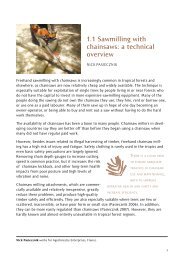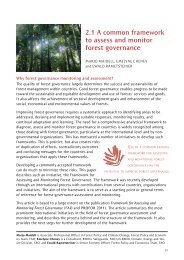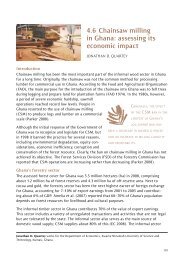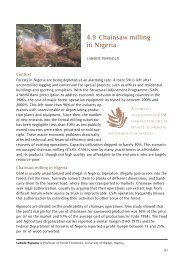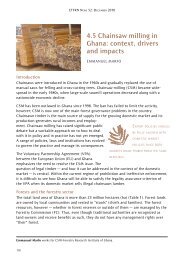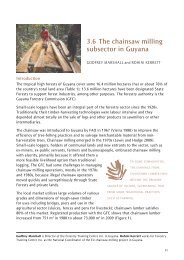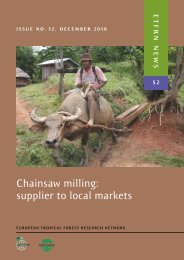Chainsaw milling: supplier to local markets - European Tropical ...
Chainsaw milling: supplier to local markets - European Tropical ...
Chainsaw milling: supplier to local markets - European Tropical ...
You also want an ePaper? Increase the reach of your titles
YUMPU automatically turns print PDFs into web optimized ePapers that Google loves.
4.7 chaiNsaw milliNg iN kENya<br />
Farmers are approached by several types of buyers:<br />
• private individuals, who require timber for a project — they hire a chainsaw opera<strong>to</strong>r<br />
or a chainsaw and bench saw in combination <strong>to</strong> saw the trees in<strong>to</strong> the desired<br />
dimensions; this category also includes some larger corporate users such as tea<br />
fac<strong>to</strong>ries, schools and hospitals, which mainly fell trees for fuelwood (valuable<br />
timber trees are commonly felled for fuelwood);<br />
• timber dealers, who buy standing trees —they either saw them on-site with their own<br />
bench saw and/or chainsaw or take the logs <strong>to</strong> a sawmill; the dealers sell the sawn<br />
timber <strong>to</strong> other dealers or end users;<br />
• timber brokers, who buy standing trees from farmers and sell them <strong>to</strong> processors,<br />
making a profit without any physical effort — brokers usually offer the lowest prices<br />
<strong>to</strong> farmers; and<br />
• tree finders, who are hired by any of the three groups above <strong>to</strong> locate suitable trees<br />
and negotiate the cheapest price —they are paid a commission by the processors/<br />
brokers, with the amount depending on the number of trees found and the price<br />
negotiated.<br />
institutional and legal framework<br />
since independence, many constraints have hampered the development of the forest<br />
sec<strong>to</strong>r. a weak legal framework prevented the private sec<strong>to</strong>r or communities from<br />
participating in forest management, and the Forest Department (FD) from managing<br />
resources outside gazetted forests. The Forest Act 2005 put<br />
in place the reforms necessary <strong>to</strong> revitalize the sec<strong>to</strong>r. They<br />
provide for the participation of more stakeholders in the<br />
management and conservation of forests.<br />
under the old Forest Act, the FD was characterized by<br />
centralized decision-making and inadequate financing. This<br />
resulted in ineffective management, best illustrated by the<br />
poor condition of industrial plantations and the degradation<br />
of indigenous forests. under the new act, sustainable<br />
forest management is being carried out by kFs.<br />
The service is charged with forest administration, policy<br />
development, forest regulation, training, extension and protection of natural forests. it<br />
also promotes commercial tree growing by the private sec<strong>to</strong>r, farmers and communities by<br />
providing incentives for forest development. in addition, kFs works closely with various<br />
sec<strong>to</strong>rs, such as agriculture, water, land, energy and <strong>to</strong>urism.<br />
Policy and legislation<br />
before the 1999 ban on wood harvesting from government plantations, timber dealers<br />
who bought trees from plantations used Csm <strong>to</strong> convert them in<strong>to</strong> beams for ease of<br />
transport. Csm was also used <strong>to</strong> convert illegally acquired timber from both government<br />
indigenous and plantation forests. its use has since extended <strong>to</strong> timber of commercial<br />
sizes, especially on farms.<br />
169



